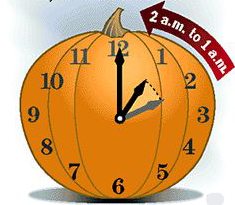
Sunday November 1, 2020 | LANGFORD, BC
by Mary P Brooke, B.Sc. editor | Island Social Trends
Despite a certain degree of public pressure on the BC government in the year or two preceding 2020, the onslaught of all the legitimate worries about COVID-19 put legislative changes about Daylight Savings Time (to become just a Standard Pacific Time) on the back burner. That’s what Premier John Horgan said somewhere in the swirl of COVID-time this year.
So as Halloween night drew to a close, people who headed to bed before midnight turned their clocks back one hour as the ‘fall back’ of the end of daylight savings time for another year drew to a close.

The official turn-back-the-clock came at 2:00 am this morning, Sunday November 1.
Daylight or otherwise, Pacific Time Zone is eight hours behind Greenwich Mean Time (or UTC), and three hours behind Eastern Time (of relevance to anyone who follows national politics).
Some extra sleep:
Either way, each of us had an opportunity to get an extra hour of sleep (or technically, to get back that hour we forfeited in the spring when this year’s phase of Daylight Savings Time started on Sunday March 8, just as the pandemic was grinding in on BC and the world). Sunrise and sunset were about one hour later that day, compared to the day before — there was more light in the evening.
Now sunset comes fast … tonight it arrived at 4:53 pm on south Vancouver Island. Welcome to the beginning of COVID-winter 2020.
The benefits of additional sleep in a busy world are obvious. Being well-rested improves nearly everything, including the ability to concentrate, maintain an even mood, and allowing the body to do its regular overnight healing (cell repair and dream-state activity).
Technical things:
Most computerized things make the change automatically from the hour-forward, to hour-back — including smartphones, TVs, and computers. Manual things require that twice-a-year adjustment so the time reads right — things such as the clock over your stove or on the dash of an older car.
Why change, and to what new paradigm?
People’s concerns about Daylight Savings Time and wanting to keep time unchanged throughout the year stem from a noted rash of accidents, forgetfulness or other issues related to disruption of routine. While those events and interruptions are troublesome or worse for some, for most people life just moves on.
People arguing to stay on Daylight Savings Time permanently also argue for the societal benefits of an evening that has more daylight. However, that is more of a reflection of how we perceive that work days should or must be done in the standard 9 to 5 time frame (which may very well be changing due to the realization for many that workplaces can be remote — including from home — and that schedules can be flexible — including recreation in mid-day hours and working in the evening instead).
People arguing to stay on Standard Time permanently are tying things more to astronomical considerations (how the world turns and the relation of Earth to other cycles and orbits) and how the plant world stays in rhythm with ‘normal’ (standard time), not an adjusted clock. The benefits of remaining on standard time include aspects of agriculture not to mention people being more in synch with the natural world.
The COVID winter:
Without a vaccine or established treatment for COVID-19 infection — together with the significant negative economic impacts of the pandemic for most people and businesses — most political, public health, and community leaders are warning of a ‘tough winter’ for 2020 into 2021.
Somehow this small action of turning clocks back to Standard Time seems aligned with ‘settling in’ for the long dark nights.




